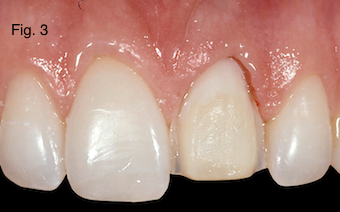Restoring Discolored Endodontically Treated Teeth: Case 3
By Frank Spear on March 21, 2014 |In the previous article in this series I showed an example of isolated discoloration in the cervical of two central incisors that should have been masked with composite before the final prep and impression but wasn’t. This required the lab to make three sets of veneers to get an acceptable result. In this article I will show you a more acceptable way to approach the problem of isolated discoloration.
Case 3: Discolored endodontically treated central incisor, previously bleached three times over 20 years.
This patient presented to me unhappy with the discoloration of her left central incisor (Figure 1). The tooth was traumatized when she was young and required endodontic therapy, although the trauma did not result in any periodontal damage or root resorption. In addition the only restoration is a composite in the access cavity.
The bad news is that the tooth has been internally bleached three times over the last 20 years and the patient wants a more permanent solution to the discoloration. After prepping the tooth for a veneer, I discovered that the overall prep color wasn’t as bad as I expected. It was manageable with .7mm of facial reduction everywhere except the discolored cervical 3 mm (Figure 2).


Unlike the case in the previous article, I chose to solve this one by prepping an additional .3 mm into the cervical 3 mm so I could mask the discoloration with opacious composite. The composite shade was chosen to match the cervical third of the adjacent right central incisor. Following placement the prep and final impression were completed. Note the margins are .7 mm below tissue and the veneer will extend apically beyond the composite and onto the margin of natural tooth structure (Figure 3).


By masking the discoloration with composite it allowed the technician to make a translucent final restoration. This also made it possible to seat it with translucent cement, producing a much better result than if I had tried to have the technician opacify the cervical third of the veneer. Since the composite can’t be etched with phosphoric acid, I air abraded the entire prep and composite with Aluminum Oxide prior to acid etching the natural tooth structure and placing my bonding agent (Figure 4).